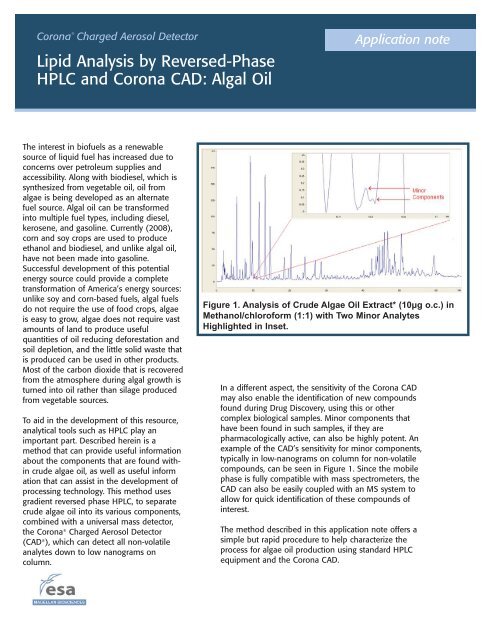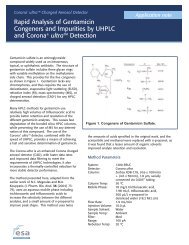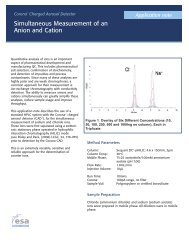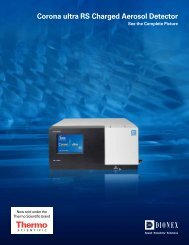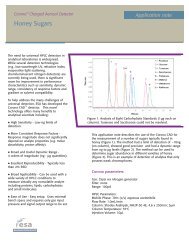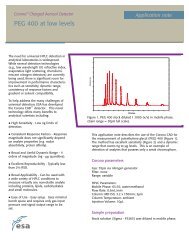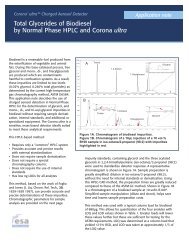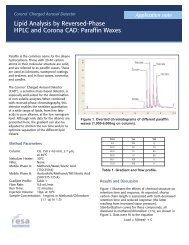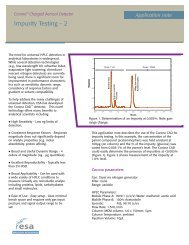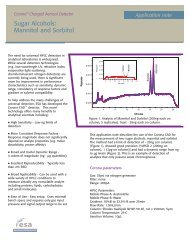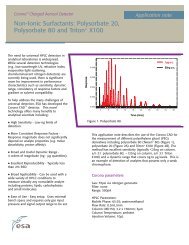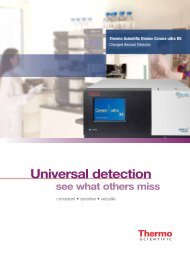Lipid Analysis by Reverse-Phase HPLC and Corona CAD: Algal Oil
Lipid Analysis by Reverse-Phase HPLC and Corona CAD: Algal Oil
Lipid Analysis by Reverse-Phase HPLC and Corona CAD: Algal Oil
Create successful ePaper yourself
Turn your PDF publications into a flip-book with our unique Google optimized e-Paper software.
<strong>Corona</strong> ® Charged Aerosol Detector<strong>Lipid</strong> <strong>Analysis</strong> <strong>by</strong> <strong>Reverse</strong>d-<strong>Phase</strong><strong>HPLC</strong> <strong>and</strong> <strong>Corona</strong> <strong>CAD</strong>: <strong>Algal</strong> <strong>Oil</strong>Application noteThe interest in biofuels as a renewablesource of liquid fuel has increased due toconcerns over petroleum supplies <strong>and</strong>accessibility. Along with biodiesel, which issynthesized from vegetable oil, oil fromalgae is being developed as an alternatefuel source. <strong>Algal</strong> oil can be transformedinto multiple fuel types, including diesel,kerosene, <strong>and</strong> gasoline. Currently (2008),corn <strong>and</strong> soy crops are used to produceethanol <strong>and</strong> biodiesel, <strong>and</strong> unlike algal oil,have not been made into gasoline.Successful development of this potentialenergy source could provide a completetransformation of America’s energy sources:unlike soy <strong>and</strong> corn-based fuels, algal fuelsdo not require the use of food crops, algaeis easy to grow, algae does not require vastamounts of l<strong>and</strong> to produce usefulquantities of oil reducing deforestation <strong>and</strong>soil depletion, <strong>and</strong> the little solid waste thatis produced can be used in other products.Most of the carbon dioxide that is recoveredfrom the atmosphere during algal growth isturned into oil rather than silage producedfrom vegetable sources.To aid in the development of this resource,analytical tools such as <strong>HPLC</strong> play animportant part. Described herein is amethod that can provide useful informationabout the components that are found withincrude algae oil, as well as useful information that can assist in the development ofprocessing technology. This method usesgradient reversed phase <strong>HPLC</strong>, to separatecrude algae oil into its various components,combined with a universal mass detector,the <strong>Corona</strong> ® Charged Aerosol Detector(<strong>CAD</strong> ® ), which can detect all non-volatileanalytes down to low nanograms oncolumn.Figure 1. <strong>Analysis</strong> of Crude Algae <strong>Oil</strong> Extract* (10μg o.c.) inMethanol/chloroform (1:1) with Two Minor AnalytesHighlighted in Inset.In a different aspect, the sensitivity of the <strong>Corona</strong> <strong>CAD</strong>may also enable the identification of new compoundsfound during Drug Discovery, using this or othercomplex biological samples. Minor components thathave been found in such samples, if they arepharmacologically active, can also be highly potent. Anexample of the <strong>CAD</strong>’s sensitivity for minor components,typically in low-nanograms on column for non-volatilecompounds, can be seen in Figure 1. Since the mobilephase is fully compatible with mass spectrometers, the<strong>CAD</strong> can also be easily coupled with an MS system toallow for quick identification of these compounds ofinterest.The method described in this application note offers asimple but rapid procedure to help characterize theprocess for algae oil production using st<strong>and</strong>ard <strong>HPLC</strong>equipment <strong>and</strong> the <strong>Corona</strong> <strong>CAD</strong>.
<strong>Corona</strong> ® Charged Aerosol DetectorMethod ParametersColumn: *Halo C8, 150 x 4.6 mm, 2.7 µm,at 40°CDetector: <strong>Corona</strong> <strong>CAD</strong> PlusNebulizer Heater: OnFilter:NoneMobile <strong>Phase</strong> A: Methanol/Water/Acetic Acid(750:250:4)Mobile <strong>Phase</strong> B: Acetontrilie/Methanol/THF/Acetic Acid(500:375:125:4)Gradient Profile: Table 1Flow Rate: 0.8 mL/minRun Time: 72 minutesInjection Volume: 10 µL at 10°CTime %A %B0.0 100 040.0 60 7060.0 10 9065.0 10 9065.1 100 072.0 100 0Table 1. Gradient <strong>and</strong> Flow Profile.Sample Concentration: 1mg/mL in Methanol/chloroform (1:1)Figure 2. <strong>Analysis</strong> of Crude Algae <strong>Oil</strong> Extract* (10μg o.c.) inMethanol/chloroform (1:1) with General <strong>Lipid</strong> ClassesOutlined.Figure 3. <strong>Analysis</strong> of Crude Algae <strong>Oil</strong> Extract* (10μg o.c.)Stripped of Hydrophilic Materials, in Methanol/chloroform(1:1).
The <strong>Corona</strong>®Charged Aerosol DetectorResults <strong>and</strong> DiscussionSeveral classes of lipids are identifiable using themethod: free fatty acids, fatty alcohols, phospholipids,mono-, di-, <strong>and</strong> triacyl-glycerides, sterols <strong>and</strong> steroids,<strong>and</strong> fat-soluble vitamins (not shown) are all present ina single chromatogram, as shown in Figure 2. Also,many of these compounds are not visible with UV/Visdetection alone, which makes the <strong>Corona</strong> <strong>CAD</strong> theideal detector for these samples. Another benefit liesin the relative uniformity of response of the <strong>CAD</strong> withdifferent materials: typical response factors lie within20% of each other, making estimates of mass-% frompeak area-% more reliable <strong>and</strong> accurate than withother means of detection.In developing a process for biofuels from algal oil, oneof the first steps is to remove the hydrophilic material,leaving the more suitable, hydrophobic material forfurther process development. A different sample ofalgal oil that was stripped of hydrophilic material waschromatographed using the same conditions <strong>and</strong> isshown in Figure 3. This is algal oil is different thanthat depicted in Figure 2, but the load of 10 µg is thesame. As can be seen, the higher amount ofhydrophobic analytes causes the baseline to appearraised. A lower amount of sample injected maylessen this effect.Once the crude material has been transformed into abiofuel, like biodiesel, the <strong>Corona</strong> <strong>CAD</strong> can also beused to further characterize the finished product.Application Note #70-8305, “Biodiesel <strong>Analysis</strong> <strong>by</strong>Normal <strong>Phase</strong> <strong>HPLC</strong> <strong>and</strong> <strong>Corona</strong> <strong>CAD</strong>,” quantifiesremaining free <strong>and</strong> bound glyceride contaminants thatoccur during base-catalyzed trans-esterification ofvegetable oils.ConclusionsThis application note describes an analytical methodwhich effectively characterizes lipid samplesobtained from algae oil extracts. The <strong>Corona</strong> <strong>CAD</strong>has the sensitivity to see low-level compounds forthe researcher or analytical chemist, <strong>and</strong> it hasreduced chemical requirements (analytes are onlyrequired to not be volatile) to allow for a broadrange of molecular species to be measured. Withthis analysis, it is also possible to generate importantinformation for the process development scientistworking on a robust <strong>and</strong> well-qualified method. Theuniformity of response for analytes on the <strong>Corona</strong><strong>CAD</strong> allows for a more accurate picture of analytequantities than other methods of detection.Ordering Information<strong>Corona</strong> Plus Charged Aerosol Detector 70-7041Thermal Organizer Module70-5499TANitrogen generator 70-6003Pump, model 584 RS-232** 70-7058Quaternary Low Pressure Gradient 70-5260Autosampler, model 542 70-4152EZChrom Elite (TM) for ESA softwareincluding PC 70-5073*ESA wishes to thank Mac-Mod Analytical, Inc. (Chadds Ford, PA) for theuse of their column <strong>and</strong> Sapphire Energy (San Diego, CA) for the algal extract.**Modification required - contact ESA Technical Support.ESA Biosciences, Inc.22 Alpha RoadChelmsford, MA 01824-4171USA+1 978.250.7000 Phone+1 978.250.7090 Fax+1 800.959.5095 US Toll freeEmail: info@esainc.comwww.esainc.comESA AnalyticalBrook Farm, Dorton, AylesburyBuckinghamshire HP18 9NHEngl<strong>and</strong>+44 (0)1844 239381 Phone+44 (0)1844 239382 FaxEmail: info@esainc.comwww.esainc.comESA Biosciences, Inc. is an ISO 9001 <strong>and</strong> 13485 Certified CompanyESA, <strong>Corona</strong> <strong>and</strong> <strong>CAD</strong> are registered trademarks of ESA Biosciences, Inc.The <strong>Corona</strong> <strong>CAD</strong> is covered <strong>by</strong> multiple patents70-8335Rev A


